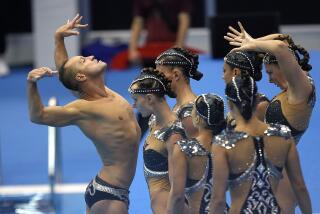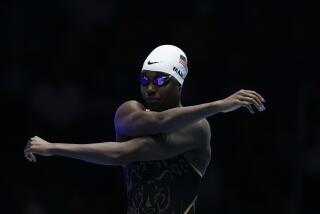Sinking Feeling : After Thousands of Hours in the Pool, Some Young Swimmers Decide to Get Out for Good, Having Suffered a Burnout While Still in Their Teens
- Share via
SAN DIEGO — He can handle losing you to another sport, another endeavor, another love. But lose you to nothing, and he loses a part of himself as well.
John Weckler heads one of the county’s most successful age-group swimming programs, El Cajon’s Heartland Swim Assn. He is proud that 40% to 50% of his national group--the level where approximately 20 of his most serious swimmers train--get college scholarships, even prouder that 95% go on to college.
When a swimmer leaves to pursue other interests, Weckler takes pride that his program has helped to shape that individual.
“When we lose kids to other things, what’s wrong with that?” Weckler said. “That’s the choice they make. I don’t call it burnout if they move on to something else. I just hate losing them to nothing.”
Losing them to nothing is really losing them to burnout, a syndrome that afflicts athletes when they have had enough of the demanding hours and either quit or take an extended break. Burnout is something Weckler takes seriously.
“It hurts him to see them go,” said Judd Hulbert, Grossmont High’s swim coach and Weckler’s good friend.
The departure of Chula Vista High’s Natasha Martin last summer was a blow. Martin, 17, quit Weckler’s program after spending 11 years in competitive swimming.
“I wish I had found a way to motivate her all the time,” Weckler said. “That’s my failure as well as hers. People say I’m too hard on myself, but she was worth it. Everyone is.”
Everyone may be worth it, but some simply aren’t cut out to put in the commitment of 30-35 hours a week Weckler said it takes to compete at the national and international levels.
“You can’t look at it any differently than a job,” he said. “You have to put in that kind of time to get there.”
Deena Deardurff-Schmidt, 32, Olympic gold medalist and Grossmont College women’s swim coach, put in her time.
“I (trained) for a zillion years,” she said, “and I don’t want to do it any more.”
At 15, Deardurff-Schmidt struck gold in the 1972 Olympics in Munich as a member of the United States’ 400-yard medley relay team. Four years later, after failing to qualify for the Montreal games, she opted for a coaching career.
“After the first Olympics, I wasn’t looking four years ahead, but the second time I was,” she said. “I didn’t know if I wanted to go through all that again. The stress gets you down. I swam and ate. That’s it. You get tired. If you aren’t succeeding, I can understand why you wouldn’t stay in it. Why would you want to?”
This is a question swimmers with years of club training often ask during high school, when they wonder if the thousands of miles they have logged have been worth it.
“I believe that mentally you get to a point when you just can’t do it any more,” Hulbert said. “All the swimming takes a lot out of you. It’s so time-consuming and demanding.”
But commitment is a factor for those who wish to be successful in any sport. What makes swimmers different?
Poway High senior Eric Innis quit swimming after 9 1/2 years with Rancho Bernardo, now the Blue Fins Swim Team, and UPPR (United Poway Swim Club).
“You can’t stop for a long period of time and think you’re going to get a away with it,” Innis said. “It requires total dedication.”
Chris Procopio of Poway High quit after three years of club and two seasons of high school.
“You can’t miss a day,” he said. “You work for your times and, if you miss a practice, you have to start over. It’s unusual compared to most sports.”
Both swimmers and coaches say burnout often occurs because children have been pushed too hard by eager parents and misguided coaches.
“Sometimes,” Deardurff-Schmidt said, “a club will get a hold of a good age-group swimmer, and they’ll want to turn them into a national-caliber swimmer right away, whether they’re ready or not.”
Weckler said Heartland’s philosophy is aimed at keeping younger swimmers in the sport long enough to get a return on all the money their parents have invested. He does this by recommending only three or four one-hour sessions a week for the 9-13-year-olds.
“I’ve had vicious arguments with coaches about that,” Weckler said. “We have problems with younger kids wanting to do more and parents wanting them to do more, but we want them swimming when they’re 16.”
Hulbert said high school swimmers get discouraged when they can’t swim the times they did when they were younger.
“Kids have a lot of success with it when they’re young,” Hulbert said. “Then when they’re 14 or 15, they can’t swim the times they used to. As they get older, their bodies change, and they have to put a lot more time in the water just to stay even.”
Weckler said another problem swimmers face is pressure from parents.
“Kids are being pushed too hard,” he said. “We can’t control what goes on at home. I hear them saying to their kids at meets, ‘You embarrassed me.’ So you get swimmers who love going to practice but hate going to meets.”
Chula Vista’s Martin, Weckler said, was one of Heartland’s most talented swimmers. But she fanned her own flame and eventually burned out.
“I never loved swimming, I liked it,” Martin said. “I was dedicated on and off.”
It was Martin’s parents who nudged her into the sport, she said, and her coaches who tried to hold her interest through the years.
“My parents wanted me to do something with my time,” she said. “But I’m real lazy. (Coaches) gave me shorter workouts than everyone else, and I still couldn’t do it. The less they gave me, the less I wanted to do.”
Not all coaches are as accommodating. Swimmers often complain that their workouts aren’t designed with their events in mind.
“A lot of coaches get into a pattern of double workouts and long distance because everyone else is doing it,” Deardurff-Schmidt said, “and they don’t evaluate their own programs.”
Said Procopio: “Basically, I was a sprinter. I didn’t like all that distance. I’m too big to do distance. My body wasn’t made for it.”
Deardurff-Schmidt said she was more willing to put in the work needed, “because I had so much more to gain,” she said. “I was traveling in and out of the country. There were so many rewards for the level I was at.”
Many of her friends weren’t as fortunate.
“So many of my friends quit . . . or they should have,” she said. “They weren’t improving, and they started to hate it.”
Weckler said he has only lost one or two swimmers to what he described as “too much too soon” in his five years at Heartland.
“What I think burnout is,” he said, “is kids are in it for so long they get to the point where they haven’t done anything else. They also lose sight of what they’re trying to accomplish. They go through practice not knowing what they’re doing.”
Another common complaint is that swimming monopolizes time.
“I didn’t have a social life at all,” Martin said. “You get back from workout late and you have no time to go out, except Sunday, and then all you want to do is sleep.”
Swimming also differs from other endurance sports in that there’s repetition without a change of scenery, as there is in running or biking.
“Two of my best friends have also burned out,” Procopio said. “We used to joke about getting sick of looking at the bottom pool tiles all the time.”
Some find enjoyment in it. Mike Picotte of Swim San Diego and Mira Mesa High is the senior national champion in the 200-yard freestyle. He said he welcomes the repetition.
“It’s relaxing,” he said. “I like putting my head down and going back and forth.”
But for others, Weckler said, sport emulates life. The burnout syndrome follows society’s lead.
“Burnout occurs in life, that’s a statement about society,” he said. “Kids aren’t just burned out on tennis, gymnastics, swimming or anything else, they’re burned out on life. How can you blame that on swimming?”
More to Read
Go beyond the scoreboard
Get the latest on L.A.'s teams in the daily Sports Report newsletter.
You may occasionally receive promotional content from the Los Angeles Times.






